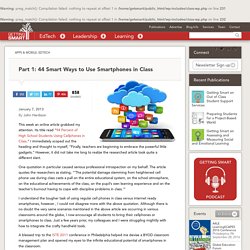

BYOD Begins With Trust and Respect. I have written extensively over the past couple of years about our Bring Your Own Device (BYOD) initiative at New Milford High School at the Huffington Post and on my own blog.

It has been interesting to look back at all my blog posts to see how far we have come with BYOD at NMHS. My first ever post on the topic just provided a small glimpse at the possibilities inherent when students are empowered to use the technology that they already posses to enhance their learning experience. Image credit: It was our desire and quest to create a school culture and learning environments that were more reminiscent of the real world that our learners would soon be a part of that drove change in this area. When I reflect upon how the program has evolved into it's current state I cannot help but to think about the most important change that was made recently. By logging into the New Milford wireless network, they are accepting the terms of the New Milford Student Responsible Use Guidelines.
Mobile Learning: 50+ Resources & Tips. I believe mobile devices will transform education. This is why I created a free ebook, Effective Mobile Learning: 50+ Quick Tips & Resources with helpful tips and several resources to help support this trend. One reason is because mobile devices are designed in a way that forces the teacher to give control to the learner. When we equip a classroom with iPads, iPods, small tablets, or cellphones the learning is literally put in the hands of the students. The teacher has to facilitate and walk around the room to manage the learning. Below are a list of 50+ Mobile Learning resources & growing! Mobile Learning Free Ebooks Mobile Learning Posts/Presentations I’ve Given. 5 Ways the BYOD Model Can Benefit Special Education Classrooms. We have a love-hate thing going with the idea of a BYOD (Bring Your Own Device) classroom.

We love that each student in a BYOD classroom has the ability to work on the technology with which they are most comfortable. And we really love that teachers don't have to deal with the logistics of school-owned technology. But we really don't like the fact that teachers in BYOD schools have to adapt their lessons to work on a variety of mediums and with a variety of platforms. Talk about a workload! That said, there's a lot to love with the BYOD model, especially when it comes to special education.
Benefit #1: Students Choose the Tech That Fits Them Best We all have our technology preferences and the last thing a student needs is to get used to one type of technology at home and be forced to use another at school. Benefit #2: Students Can Download the Apps They Need. 50 Shades of Mobile. Bring Your Own Device. Four Smart Ways to Use Cell Phones in Class. Digital Tools Teaching Strategies Erin Scott By Jennifer Carey A good rule of thumb for any classroom use of cellphones: the lesson/activity must be engaging as well as productive.

You don’t want technology for the sake of technology (and students aren’t going to be intrinsically fascinated with a device they use routinely when they’re outside of school). If the students don’t enjoy what they’re doing, they will be more tempted to use their phones inappropriately. Here are some ideas: IN-CLASS POLLING/QUIZZING. IN-CLASS BACK-CHANNELING: Backchanneling refers to the use of networks & social media to maintain an online, real-time conversation alongside spoken remarks. Backchanneling can be a great way to give quiet students a voice, to introduce additional facts and insights during a lesson, or simply to encourage “conversation” during lecture or group readings when you don’t want to actually interrupt the presentation. Poll Everywhere can also be used for this purpose. ORGANIZING RESEARCH. 44 Smart Ways to Use Smartphones in Class (Part 1) - Getting Smart by @JohnHardison1 - This week an online article grabbed my attention.

Its title read “94 Percent of High School Students Using Cellphones in Class.” I immediately scoped out the heading and thought to myself, “Finally, teachers are beginning to embrace the powerful little gadgets.” However, it did not take me long to realize the researched article took quite a different slant. One quotation in particular caused serious professional introspection on my behalf. The article quotes the researchers as stating, “‘The potential damage stemming from heightened cell phone use during class casts a pall on the entire educational system, on the school atmosphere, on the educational achievements of the class, on the pupil’s own learning experience and on the teacher’s burnout having to cope with discipline problems in class.’”
I understand the tougher task of using regular cell phones in class versus internet ready smartphones, however , I could not disagree more with the above quotation.